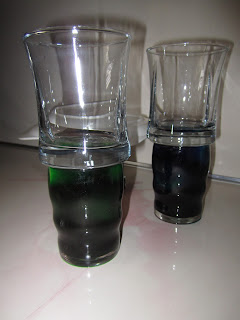Find some circular objects to trace. I used circles from 2.5-5 inches wide by finding wine glasses and candle holders. Trace and cut out 20 circles of the same size from your card stock
 Now the trickiest part. We want to fold the circles at 3 equidistant points. We need an equilateral triangle that will fit into the circles. To determine the measurement for each side of the triangle, measure the diameter of your circle.
Now the trickiest part. We want to fold the circles at 3 equidistant points. We need an equilateral triangle that will fit into the circles. To determine the measurement for each side of the triangle, measure the diameter of your circle.Multiply the diameter by 0.866. My diameter was 2 and 11/16 inches (2.6875). My triangle sides need to be 2.6875 x 0.866 = 2.33. 2.33 inches is my side length needed.
To make the triangle, use the corner of one sheet of card stock. Measure your side length from the corner along one side and draw a dot.

Now from the corner measure out the distance again in a few different places. Draw dots and connect them with an arc.

Place the 0 of the ruler at the first dot and measure out your side length, moving the ruler until it intersects with the arc at your length. Make an x.

Draw a line to connect the original dot with the X. Then draw a line from the X to the corner. This is your triangle!

Cut it out. Place it on a circle to see how well it fits. It doesn't have to be perfectly perfect and probably won't be unless all of your circles are precise.

Mark each circle at the corners of the triangle. You don't have to mark them this darkly. I did so just to make it easily visible. You just need a faint mark.

Now we use the ruler to fold a crease from point to point. Do this for all 20 circles.


Grab your super glue and begin to glue a chain of triangles. Super glue really works best. Elmer's glue is too thick and the glue sticks didn't hold the circles for long in our humid summer.
Glue the triangles up-down-up-down. You want to make a chain of 10 to form the middle of your polyhedron. I held the sides in place for about 10 seconds and then used clothespins to secure the hold.
Use 5 triangles to form the caps. All the triangles should be pointing up to form the end.
Now we have 2 caps and the middle ring. Glue them in place. Clothespins are great here because the sides will really want to pull apart.
Let it dry a few minutes. It won't take long, super glue dries so fast. I used a hole punch to put a hole through one flap. Fishing line tied through the hole and pinned to the ceiling with a pushpin worked great for hanging them up. They look so whimsical in the nursery and spin when the fan is on. Little Man loves them! "Balloon" was one of his first words and he loves to point to these "paper balloons".
Craft time: Little over an hour per polyhedron
Cost: $1-3 depending on size



















